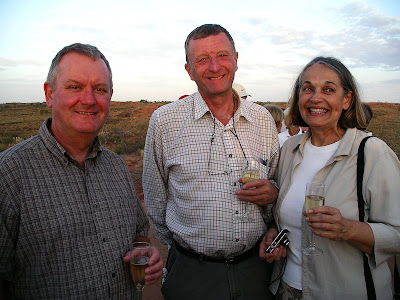Finally having some WiFi connection for a reasonable price and nothing particularly pressing to do for the day, I decide to have a go at setting up a blog. Sue is complaining that it would be much easier to have an online diary than having to send individual emails to everyone. OK, OK, I’m on to it.
I sit in the garden at Traveller’s Oasis and join Blogger - easy. I start uploading photos and add text - easy. I post the results – disaster. Words and pictures are all over the place, everything out of order. Sue brings breakfast, tea, coffee, lunch. She gets bored and goes off into town on her own. I sit in paradise tearing my hair out and grinding my teeth - blogging a dead horse. Eventually I find a format that seems to work. It doesn’t work as I would like it – everything is in reverse order for starters – but I think we are stuck with it. It takes most of the day to post the first three days of the trip, but at least I know how it works now.

(Sue) I wandered off up through the main drag where we had walked the previous evening. When I got to The Esplanade, I realised that what we had assumed to be an architectural water feature /cityscape, was actually a swimming lagoon. It was absolutely heaving, there being droves of people swimming, paddling, lounging and making use of the numerous public BBQs. I thought that I had better take a few photos so Phil would be able to see what he had missed when I returned.
I strolled towards the marina area, along the boardwalk, and hoped to find some pelicans.
Marina Flotsam
I found half a dozen or more individuals and groups of people fishing with lines on reels rather than with rods. The Aborigines seemed to favour raw prawn as bait, for grouper I think they said. I told them I was looking for pelicans, and they laughed, because I had come to the wrong side of the bay, and pointed to something on the other side that I couldn’t see.
About 10 mins later I found my first pelican, and marvelled at how big they are. I have only seen pelicans in the wild once before, in Mexico, years ago, and did not remember them being as big as these Australian birds. There were scores of birds feeding on the mud flats at low tide.
I got back to the hostel around 5.30, bearing in mind that we were going out for a BBQ at 6.30, and took Phil a present of cold beer. He was still fiddling with the net book.
We were ferried in a minibus to the sister hostel where the owner was cooking food for everyone on the barbie in the tropical palm fringed garden. It is apparently a regular event on a Monday. ‘OMG’, I thought – more crocodile, and kangaroo, and emu as well this time, served with a good range of salads. I successfully gave Phil my croc and kangaroo, and an american woman was the eager and willing recipient of my emu, which having failed to yield to my knife on second and third attempt, no longer held any interest for me.
It was great fun, enjoyed by lots of different nationalities, and included a didgeridoo playing / blowing contest, with a prize of an activity trip. If that were not enough, we had tokens for a free drink at a nightclub afterwards. Those needing to be up early for planned trips were ferried home and the rest of us were shuttled to the club for the promised drink.
We didn’t enter the competition to win a $100 bar tab. Entrants were partnered with complete strangers and had to simulate as many sexual positions as possible in 60 seconds. We made our excuses and left. (Sue)




















































